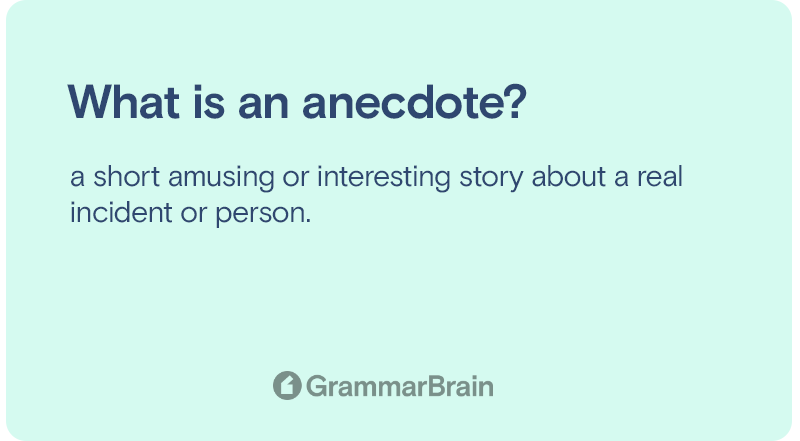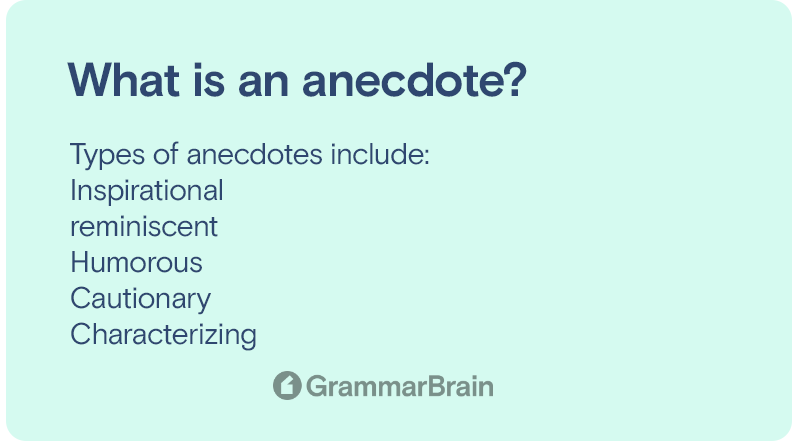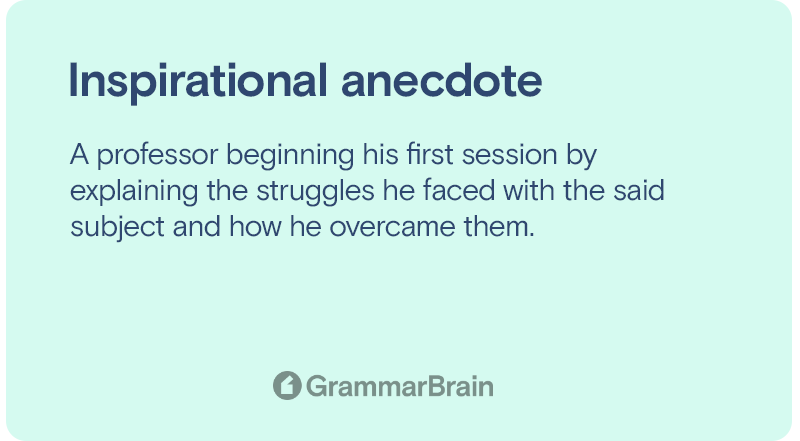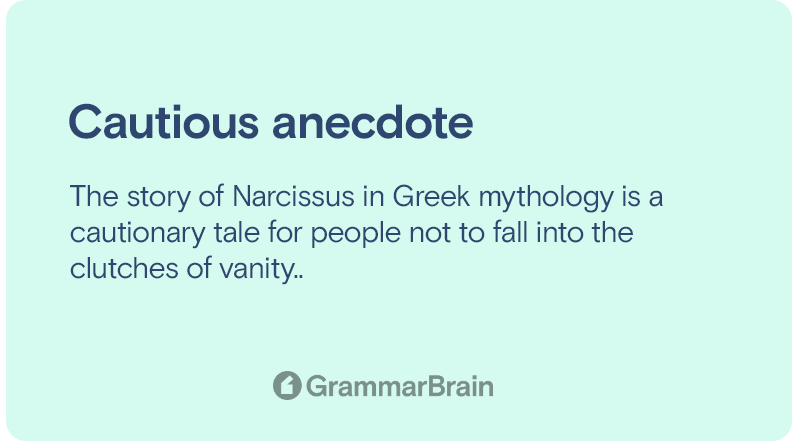What is an anecdote? How does an anecdote work? Anecdotes are short stories about interesting topics that typically have a single lesson or theme. Anecdotes are almost similar to stories that friends tell among themselves. But, when employed in literature, they may do more than just pass the time.

What is an anecdote?
Anecdotes are stories that are self-contained and brief. The majority of anecdotes focus on a single, straightforward theme or incident. They can be factual or made up or can be a real incident mixed with some embellishment.
Anecdotes can be conveyed using different tones, ranging from lighthearted jokes to grave warnings. They also typically concentrate solely on one character.
| Device | Definition |
| Anecdote /ˈanəkˌdōt/ (noun) | a short amusing or interesting story about a real incident or person. |
Purpose of an anecdote
Anecdotes can be used for a number of purposes. Anecdotes, when used in both nonfiction and fiction as a literary device, have a greater significance.
For instance, some anecdotes provide the readers with a better grasp of a character’s background or motivations by describing them in a manner that doesn’t match the central narrative.
They are used to introduce backstory or character information. Authors usually use them to share some past story of their character usually to provide substance and intrigue.
They also offer a good way to fill in plot holes in the narrative or to impede its flow. And are typically used in real life to convey an important message in a lighthearted way rather than a direct explanation.
Good anecdotes use rhetoric to their advantage. Sentimental language is usually used in inspirational anecdotes to touch the heart of the listener or reader.
Similarly, authors may use profanity or slang in humorous anecdotes to make them appear even funnier.

Anecdotes: The different types
There is no formal classification of anecdotes. But they can be broadly divided into different groups based on the purpose they serve.
These include:

Inspirational or motivational anecdotes
Anecdotes can be used by elders or experienced people to motivate youngsters by describing the challenges they have faced in their lives and how they are willing to assist them. Inspirational anecdotes are a powerful writing technique that can be used to evoke specific emotions in the reader.
This is an especially effective technique in emotional and persuasive writing. Inspirational stories frequently center on extraordinary experiences that occurred to regular individuals that the listener or reader can relate to.
Writers frequently use motivational stories to emotionally appeal to their readers. These stories can convince the readers that difficult times will pass after some time and better days are ahead.
Some examples include:
- A professor beginning his first session by explaining the struggles he faced with the said subject and how he overcame them.
- A dog shelter volunteer recounting stories of the successful rehoming of several rescue animals over the years and how they, with the help of families, found many dogs their forever homes.
- A manager recounting his early days at the company and the difficulties he faced with a group of new recruits on their induction day.
- Members of a youth organization telling stories to a group of young people about the volunteer work they have done over the years and how it changed their lives and the lives of those they helped.

Reminiscent anecdotes
The majority of anecdotes focus on the past. In anecdotes, people usually look back fondly on special periods of their lives and share the happiness of those times with others. These fond tales usually build an idealized view of the past by evoking feelings of longing or nostalgia.
But this reminiscing may not always be happy. Sometimes depressing memories can creep up in the stories, giving rise to a feeling of melancholy or despair.
Some examples include:
- A father recounts to his daughter a trip his family took when he was a child.
- A kid shares an account of his best vacation to Disney Land during a discussion about theme parks.
- A senior doctor shares his favorite experiences in the ER with the new interns.
- A war veteran recount his experiences during deployment of how war can change common people with young soldiers.

Humorous anecdotes
Anecdotes started out as stories that people would share in groups to amuse one another. Writers now use jokes to convey a much more complex topic in a lighthearted way. A humorous anecdote can be used to cheer people up following a significant or dramatic plot development in a story.
Similarly, it can also provide audiences or readers with a brief diversion from the main plot and give them something to laugh about.
Some examples of funny anecdotes include:
- A boy telling a humorous story to his friends while sitting around a campfire on a school trip.
- A father telling his kids about the funny pranks he did with his brother during his childhood days.
- A professor starting the first day of college by telling a funny story that happened during his college days.
- A speaker starting his address with a funny incident that happened to him.

Cautionary anecdotes
Anecdotes are always concise and focused. This makes the perfect tool for imparting an important lesson or message to the readers. Such “cautionary tales” often feature irresponsible or flawed individuals who suffer punishment or unfavorable outcomes by doing the wrong thing.
Religious parables, fairy tales, and historical myths all use cautionary anecdotes to inspire people to act morally by illustrating the consequences of doing otherwise.
Some examples include:
- The story of Narcissus in Greek mythology is a cautionary tale for people not to fall into the clutches of vanity.
- The fairy tale “Little Red Riding Hood” is a cautionary tale warning kids about the dangers of talking to strangers.
- Shakespeare’s “Macbeth” is a cautionary tale against power, greed, and mayhem.
- Before giving a presentation on alcohol addiction, a speaker can start with a story that details the bad effects alcohol had on the lives of someone like himself.
Characterizing anecdotes
Anecdotes are frequently employed in literature to give characters more depth by highlighting aspects of their personalities or prior experiences that don’t directly relate to the central story.
This strategy is also applied in real life, frequently with historical figures and celebrities to emphasize specific qualities or traits.
Some of these anecdote examples include:
- Everybody is familiar with the story of Alexander and his encounter with the famous Gordion Knot. It was said that whoever could untie this knot would control Asia. For many ages, kings and princes flocked to Phrygian Gordion in an effort to untangle this intricate knot, but all of them failed. When Alexander heard about the knot, he rode to Phrygian Gordium, pulled out his sword, and cut the knot. There were no instructions on how to unravel the knot. This meant that Alexander did nothing wrong by cutting it rather than untying it. This anecdote demonstrates the way Alexander approaches a problem and his capability to think outside the box. These qualities were what made him a great conqueror in the future.
How to write good anecdotes
Writing anecdotes isn’t difficult. Anecdotes can be used in a myriad of forms of writing, including general fiction and non-fiction works, speeches, essays, and even school or college works.
Using anecdotes while writing improves the writer’s skills and makes the text engaging. There are some tips writers can use to craft excellent anecdotes.
These include:
Have a clear objective or purpose in mind
Many writers think that, despite having fewer words, crafting anecdotes takes more effort and time. Sometimes the writers may need to express their thoughts in a limited number of words. All these can make using anecdotes a bit difficult.
The first step to crafting a good anecdote is to define the purpose or intention of the text, whether it is to make the reader laugh or to give some serious advice.
After this objective is clear, writers can design their anecdotes around it.
Begin with the action
Essays usually begin with an introduction that gives the reader an idea about the topic that is about to be discussed in detail. But writers can forgo this by using anecdotes and jumping directly into the story.
When compared to boring introductory paragraphs, using quirky anecdotes, in the beginning, can easily hold the attention of the readers.
Many famous fiction writers, like Malcolm Gladwell, use this technique to capture the attention of readers.
Create a short anecdote
An anecdote is brief, so it is important to stay true to its purpose and not include unnecessary details. Rereading the writing while viewing it from the perspective of another person can help writers identify unnecessary details in the text.
The target audience must always be taken into account. For example, while employing scientific terminology, writers should be prepared for the possibility that some listeners won’t comprehend what they’re saying.
It’s best to choose the alternative collocation because further explanation will just make things worse.
Include a clear conclusion
The writers should make sure that the readers will be able to tell when the anecdote is ending. Writers can use terms like “and that’s what happened” to indicate the end of anecdotes. The ending of anecdotes is heavily dependent on the message they put forth.
FAQs
What is the difference between an anecdote and a short story?
Anecdotes are typically one or two paragraphs long at most. Stories are much longer than anecdotes. When writers create stories, they have far more room for detail and put more work into making the readers feel immersed in the narrative.
What are the things a writer can include in anecdotes?
Anecdotes, as they are meant to be brief, typically center on a single main character, with very little information about supporting characters.
The narratives are also similarly kept simple by typically concentrating on just one conflict or subject.
Anecdotes rely heavily on rhetoric to create the desired mood. Experienced writers who use anecdotes focus on the language they use to ensure it reflects the tone they are striving for.
How are anecdotes structured?
Anecdotes typically have a start, middle, and conclusion, like any other form of narrative. The characters and overarching ideas are introduced at the start, the conflict or action of the narrative is presented in the middle, and everything is resolved at the conclusion.
The structure of anecdotes is similar to that of stories, but everything is considerably shorter.
Anecdotes are by nature brief and straightforward; therefore, they typically follow a more rapid pace with fewer specifics.
What’s the difference between a short narrative or brief tale?
Both types are considered short stories. When referring to short stories, they are the same as a brief tale or short narrative.
Sources:
- Merriam Webster – anecdote – Definition
- Wikipedia – Anecdote
- Literary Terms – Anecdote
- Cambridge Dictionary – anecdote
Inside this article
Fact checked:
Content is rigorously reviewed by a team of qualified and experienced fact checkers. Fact checkers review articles for factual accuracy, relevance, and timeliness. Learn more.
Core lessons
Glossary
- Abstract Noun
- Accusative Case
- Anecdote
- Antonym
- Active Sentence
- Adverb
- Adjective
- Allegory
- Alliteration
- Adjective Clause
- Adjective Phrase
- Ampersand
- Anastrophe
- Adverbial Clause
- Appositive Phrase
- Clause
- Compound Adjective
- Complex Sentence
- Compound Words
- Compound Predicate
- Common Noun
- Comparative Adjective
- Comparative and Superlative
- Compound Noun
- Compound Subject
- Compound Sentence
- Copular Verb
- Collective Noun
- Colloquialism
- Conciseness
- Consonance
- Conditional
- Concrete Noun
- Conjunction
- Conjugation
- Conditional Sentence
- Comma Splice
- Correlative Conjunction
- Coordinating Conjunction
- Coordinate Adjective
- Cumulative Adjective
- Dative Case
- Determiner
- Declarative Sentence
- Declarative Statement
- Direct Object Pronoun
- Direct Object
- Diction
- Diphthong
- Dangling Modifier
- Demonstrative Pronoun
- Demonstrative Adjective
- Direct Characterization
- Definite Article
- Doublespeak
- False Dilemma Fallacy
- Future Perfect Progressive
- Future Simple
- Future Perfect Continuous
- Future Perfect
- First Conditional
- Irregular Adjective
- Irregular Verb
- Imperative Sentence
- Indefinite Article
- Intransitive Verb
- Introductory Phrase
- Indefinite Pronoun
- Indirect Characterization
- Interrogative Sentence
- Intensive Pronoun
- Inanimate Object
- Indefinite Tense
- Infinitive Phrase
- Interjection
- Intensifier
- Infinitive
- Indicative Mood
- Participle
- Parallelism
- Prepositional Phrase
- Past Simple Tense
- Past Continuous Tense
- Past Perfect Tense
- Past Progressive Tense
- Present Simple Tense
- Present Perfect Tense
- Personal Pronoun
- Personification
- Persuasive Writing
- Parallel Structure
- Phrasal Verb
- Predicate Adjective
- Predicate Nominative
- Phonetic Language
- Plural Noun
- Punctuation
- Punctuation Marks
- Preposition
- Preposition of Place
- Parts of Speech
- Possessive Adjective
- Possessive Determiner
- Possessive Case
- Possessive Noun
- Proper Adjective
- Proper Noun
- Present Participle
- Prefix
- Predicate



